John Hurrell – 31 May, 2020
The canvas or hessian rectangles are painted usually with glossy enamel, on which are glued triangular or circular shapes made of thin board, strips of knitted macramé or towelling, blocks of dry-brushed painted carpet, laminated timber polygons, oblongs of thickly applied gesso, or the previously mentioned found objects. Contrasting textures and tones abound. One particularly geometric work features highly saturated colour, but the other sixteen are far less optically harsh: more tonal than chromatic.
Melbourne artist John Nixon has a long history of using evocative, symbolically loaded, everyday objects in his geometry-focussed paintings, collages, sculptures and installations. These include bicycles, pianos, metal buckets, and scythes. Many of these surfaced in his nineties research project Experimental Painting Workshop (EPW), if not earlier.
In his current elegant show in the narrow upstairs Two Rooms gallery, he presents small paintings of paired (usually) monochrome canvas/hessian panels, many of which also incorporate such elements, this time studio tools used for art making such as metal and wooden try squares, plastic set squares and wooden measuring rules. And also a label-less (highly reflective) tin can, a glued column of coins and a stainless steel teaspoon.
As for Nixon‘s use of (compositionally simple) coupled canvases, even though many of these pairs are not actually touching, you would still call them ‘diptychs’. The distance separating the two canvases that make up each art unit is precisely calculated. When touching, the two same-sized canvases are often not level, but with the two top and bottom edges not flush, inevitably equally misaligned.
Some though are on top (ie in front) of each other. Note that the in situ photos you see on the right are frontally aligned in the gallery space, but the works look very different when seen from the side. The thickness of the stretched canvases is important. Other works are both flat on the wall, with one above the other—ie. stacked up, higher in position.
Small Black +White Pairs is much more successful than some of Nixon’s other Auckland exhibitions, such as the large 2017 Two Rooms show of small (but exquisite) collages which was too packed—the butted up work made an encircling solid line—and the very bodily 2017 Auckland Art Gallery Toi o Tāmaki survey of paintings immersively presented on dominant brightly coloured walls.
Here there is plenty of room on the white walls for the seventeen individual paintings to breathe, for they are hung beautifully on the two parallel walls of the skinny space-interacting linearly propelled along the walls, and across the floor (between spatial opposites).
The canvas or hessian rectangles are painted usually with glossy enamel, on which are glued triangular or circular shapes made of thin board, strips of knitted macramé or towelling, blocks of dry-brushed painted carpet, laminated timber polygons, oblongs of thickly applied gesso, or the previously mentioned found objects. Contrasting textures and tones abound. One particularly geometric work features highly saturated colour, but the other sixteen are far less optically harsh: more tonal than chromatic.
Some of these works fascinate me—in a profound sense. Number 14, for example, Untitled (Pair), 2019 has a black panel and a white panel butted together. On the lefthand black panel is a solitary teaspoon. Now a teaspoon can be used in a studio for conveying coffee, pigment, sand for texture, crushed eggshell, sawdust, or liquid paint or acrylic medium. It here has a specific context linked to studio processes, referencing various work procedures needed to create exhibitable items. And it—when incorporated and displayed—looks noble.
Teaspoons outside a studio can be used for anything at all. I’ve seen war films where they have been discussed as instruments of torture. And art itself is not necessarily aligned with nobility, altruism or ethics: even if most of us wish that it was.
Nixon‘s paintings exude an iconic stasis when studied one at a time. Balance and avoidance of visual agitation dominate—though of course they are highly emotional (as most good art is likely to be—otherwise what would be the point? The aim is to be remembered).
They are simple but not bland; compact but not vacuous; intensely serene but understated; compellingly articulate but never garrulous.
John Hurrell
Recent Comments
John Hurrell
Tragic news to hear of John Nixon's passing. Such a hugely energetic contributor to experimental painting, collage and sculpture. I ...
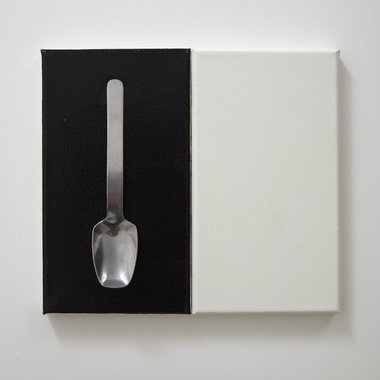

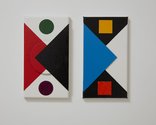

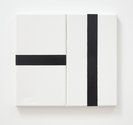




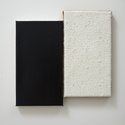











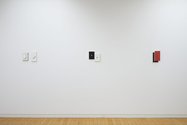

 Two Rooms presents a program of residencies and projects
Two Rooms presents a program of residencies and projects Advertising in this column
Advertising in this column



This Discussion has 1 comment.
Comment
John Hurrell, 8:47 a.m. 20 August, 2020 #
Tragic news to hear of John Nixon's passing. Such a hugely energetic contributor to experimental painting, collage and sculpture. I can remember visiting him in 1982 at Art Projects in Melbourne when he has just got back from Kassel and was presenting paintings on local newspapers. To me, as a travelling artist from Christchurch, his work and staunch ethos was a total revelation. Such a vibrant personality, one keen to generously share information. Now I'm living in Auckland and he had many wonderful shows here. The Chartwell Collection, Sue Crockford, and Two Rooms, all did some great projects with him.
https://visual.artshub.com.au/news-article/news/visual-arts/gina-fairley/vale-john-nixon-a-giant-with-a-huge-creative-footprint-260936
https://www.smh.com.au/culture/art-and-design/a-profound-loss-artist-john-nixon-dies-20200818-p55muq.html
Participate
Register to Participate.
Sign in
Sign in to an existing account.